The present
Fremantle Traffic
Bridge is 70 years old, having been opened in 1939, but it is the fourth
bridge to be built on this site. The first
bridge was built in 1866 and the three earlier
bridges are of particular interest as they illustrate the great changes which have transformed
Fremantle over the last 180 years.
When Governor Stirling established the Swan River settlement in June 1829 he founded two initial townships, a port settlement on the southern side of the Swan River, which he named
Fremantle, and an administrative capital on the North bank of the river below Mount Eliza, which he named
Perth.
By siting
Fremantle and
Perth on opposite banks of the Swan River Governor Stirling created an immediate need for bridges across the river to connect the two townsites. The first
bridge was built at the
Perth Causeway in 1843 but the necessary technical resources and money required to build the muchlarger structure required to cross the Swan River at
Fremantle did not become available until 20 years later.
After 1850, when Western Australia became a penal colony, a programme of
bridge construction was undertaken by convicts under the supervision of a Company of Royal Engineers and construction of the high level North
Fremantle Bridge was finally authorised by Governor
Hampton in 1863. This was by far the largest and most difficult
bridge to be built by the Royal Engineers with convict labour and the photo below is an early photograph of the completed structure, which was located immediately upstream of the present
Fremantle Traffic
Bridge.
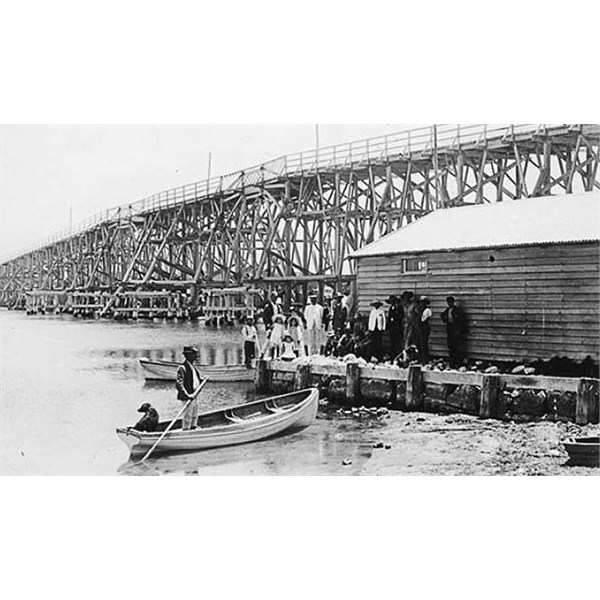
North Fremantle Bridge circa 1890.
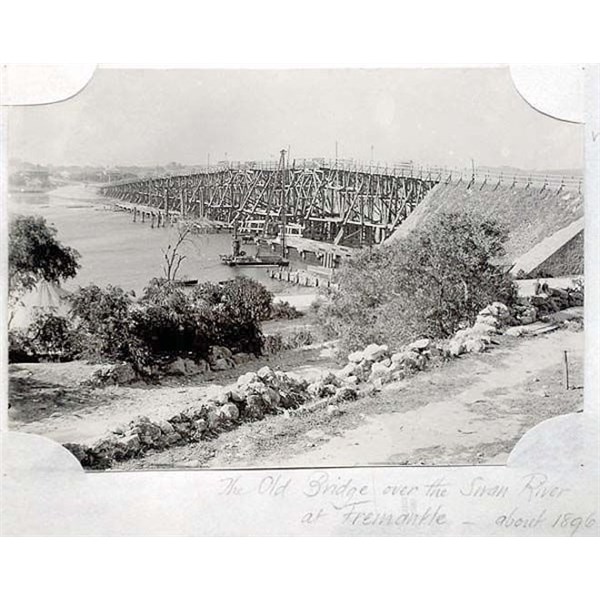
The Old Bridge Over the Swan River at Fremantle, 1896
It comprised a very long and high timber
bridge, a massive
embankment at the southern end of the
bridge and a small arch
bridge, which you can see on the right of the photograph, to provide access under the
embankment.
Work on the
bridge commenced in May 1863 and the
bridge was opened to traffic in November 1866 but was not finally completed until October 1867, a period of four and a half years. The man responsible for the design and construction of this
bridge was James Manning, a Clerk of Works attached to the Imperial Establishment who had accompanied Captain Henderson R.E. out to Western Australia in the ‘Scindian’ in 1850. He had previously trained in England as a civil engineer and, as Clerk of Works, was responsible for the construction and maintenance of jetties and bridges throughout the colony.
The
bridge had a total length of 940 feet and consisted of two 45 feet navigation spans and 33 standard spans of approximately 26 feet. The width of the
bridge deck was 18 feet. The most remarkable feature of the structure was its great height to allow barges to sail under the
bridge. The navigation clearance under the two navigation spans was 44 feet – equivalent to a five storey building.
An enormous amount of timber was used in this
bridge. In addition to the 342 round timber driven piles, some up to 55 feet in length, there were over 78,000 feet of sawn timber, all of it sawn by hand.
In the early 1890’s this high level
bridge was reported to sway in high winds and to be unsafe. In 1896 a number of inspection reports, which had been made on the
bridge between 1891 and 1896, were tabled in Parliament and resulted in the maximum allowable load on the
bridge being reduced to 1¼ tonnes. The following notice then appeared in the Government Gazette:
“On and after the 27th October 1896 and until further notice, no persons shall be permitted to drive or lead any mob of cattle , camels or horses exceeding four in number over along or across this
bridge or any part thereof…”By 1896 commercial activity in
Fremantle had increased significantly as a result of recent gold discoveries in the State and the Government decided to build a wider, stronger
bridge on the downstream side of the existing
bridge, but at a much lower level, and this became known as the Low Level
Bridge.
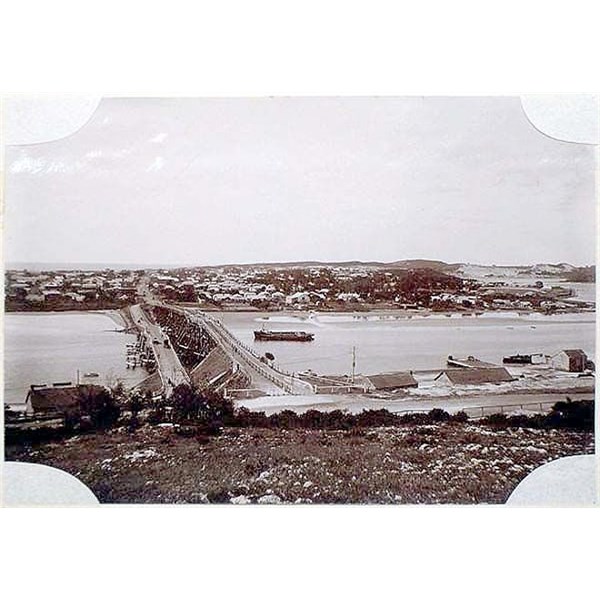
Two Bridges Over River with Cargo Boat, Fremantle 1896
This retained the 45 feet wide navigation channels but the vertical clearance under the
bridge was obviously much less. This was now acceptable because the
Fremantle to Guildford Railway had by then been constructed and replaced the old river sailing barges for the transport of goods up the Swan River.
The Low Level
Bridge was opened on the 28th September1898 but the old North
Fremantle Bridge was retained for use by pedestrians. It was intended that the Low Level
Bridge would only be a temporary structure while the
old bridge was removed and replaced with a wider structure having two 75 feet (23m) navigation openings. Nothing further was done however until ten years later, in 1908, when the
Fremantle
and North
Fremantle Municipal Councils wished to extend the
Fremantle tramway system to North
Fremantle.
The temporary low level
bridge was at the wrong level for a tramway and the approach roads were also unsuitable.
A careful inspection of the old North
Fremantle Bridge was therefore made and it was found that out of 319 piles examined 306 were absolutely sound and the others only had minor defects. In view of their excellent state it was decided to use them as a foundation for a new
bridge deck.
The old deck was removed and the piles cut down to an appropriate level while additional piles were driven to provide for a wider
bridge which could carry both road traffic and trams. The Renovated High Level
Bridge was opened on the 18th June 1909, after which the Low Level
Bridge was closed and later demolished
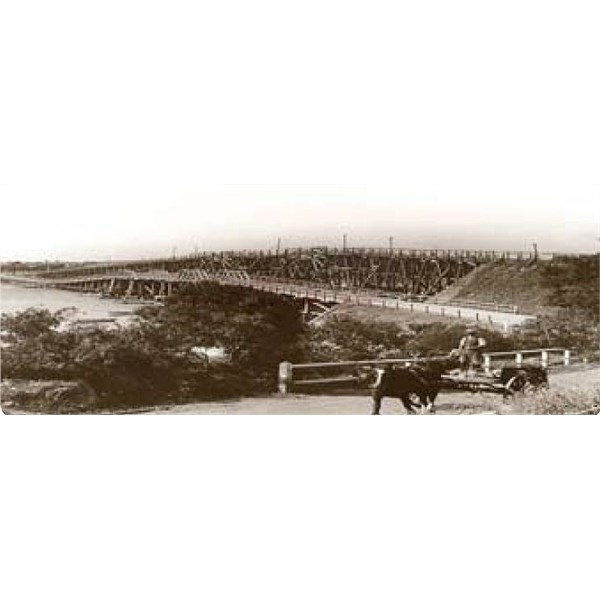
Low Level Bridge circa 1900.
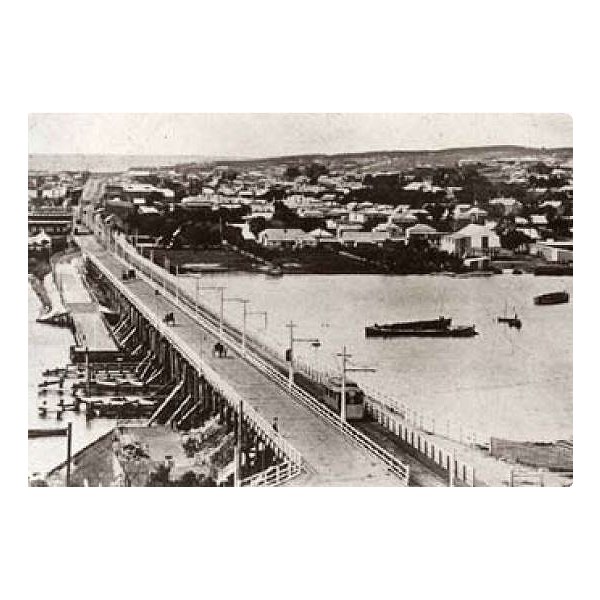
Renovated High Level Bridge
This photo above shows the Renovated
Bridge with the new tramway, and the adjacent Low Level
Bridge being demolished. The
bridge was 39 feet wide and included a 23 feet wide carriageway for two lanes of traffic, a 12 feet wide tramway and a 4 feet wide footpath. The renovations were so extensive that it was virtually a new
bridge, which therefore ranks as the third
bridge to be built on this site. In 1926 the Government created a Department of Main Roads to be responsible for construction of all main roads and associated bridges, including the Renovated High Level
Bridge. By the 1930’s the condition of the timber piles in this
bridge had deteriorated due to attack by teredo marine borers and the deck timbers required constant maintenance. It was therefore decided in 1937 to build a new
bridge immediately downstream of the existing
bridge which became known as the
Fremantle Traffic
Bridge.
A concrete
bridge was initially considered for this site at an estimated cost of £650,000 but, as there were plans to extend the existing harbour further upstream in the future, it was decided to construct a much cheaper temporary timber
bridge at an estimated cost of £75,000. In view of the planned harbour extensions the
bridge was only expected to be in use for 3 to 5 years but has now been in service for 70 years.
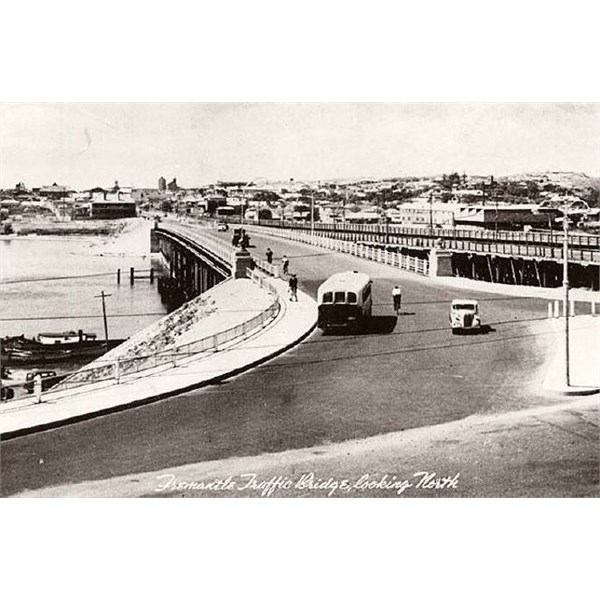
Fremantle Traffic Bridge.
The above is a photograph taken in the 1940’s, looking towards North
Fremantle, and shows the old Renovated High Level
Bridge just upstream, which was not demolished until later in 1947.
The
bridge is 720 feet (219m) long with two navigation spans, each having a clear navigation clearance of 51 feet between fender timbers, a 40 feet wide
underpass at the south abutment and 22 timber spans of 20 feet . The two navigation spans, the intervening length between them and the
underpass are spanned by a steel superstructure consisting of longitudinal girders, cross beams and stringers, supporting a timber deck.
The abutments are constructed from mass concrete founded on timber piles at the North end and on
limestone at the South end. The piers consist of Jarrah timber piles and the transverse cap beams spanning between the timber piles were originally Karri timber but have subsequently been replaced with steel channels. Apart from the steel navigation spans and
underpass, all the main longitudinal beams spanning between the piers (known as stringers) are round Wandoo logs. Transverse Jarrah bearers, which sit on top of the timber stringers, support longitudinal Jarrah deck planks.
The design and construction of the
bridge was directed by E.W. Godfrey,
bridge engineer for the Main Roads Department from 1928 to 1957, who was responsible for the construction of many outstanding bridges throughout Western Australia. For the
Fremantle Traffic
Bridge he devised an ingenious method to protect the timber piles from attack by teredo and other marine borers. It consisted of an external sleeve of concrete pipes, which were lowered over the head of each pile after they had been driven, and extended from 4 feet below the river bed to 4 feet above normal water level. The annulus or space between the pile and the inside of the pipe was then filled with clean sand. This proved successful in protecting the piles for many years.
The
Fremantle Traffic
Bridge was opened on the 15th December 1939 by the then Premier, J.C. Willcock. In his address the Premier mentioned that the opening coincided with the completion of the Stirling Highway after 6 years of construction and a change in public transport from trams to buses on this particular route. The Premier also remarked that the Commissioner of Main Roads, Mr E. Tindale, had assured him that the
bridge could also do service for the next 40 years if required and this promise has certainly been honoured.
In 1978 the
bridge deck was strengthened with a concrete overlay and major repairs to the
bridge, costing over $1 million, were carried out in 1992. These included strengthening the top sections of the piles, which had been weakened by rot at the water line, and replacing the earlier protection against marine
teredo attack by encasing the piles in concrete down to river bed level. The original Karri halfcaps have also been replaced with steel angles.
The two photos below are recent photographs of the
bridge showing these various repairs. Also of interest are the old pile stumps in the foreground. These are the remains of the original timber piles in the 1866 North
Fremantle Bridge.
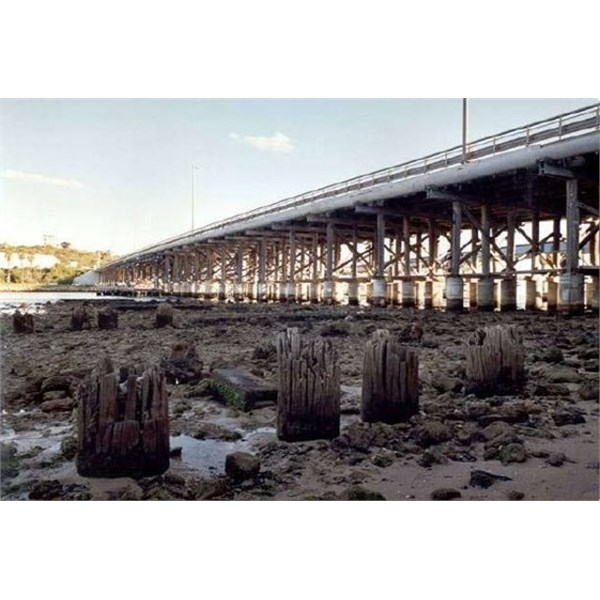
Fremantle Traffic Bridge in 2009.
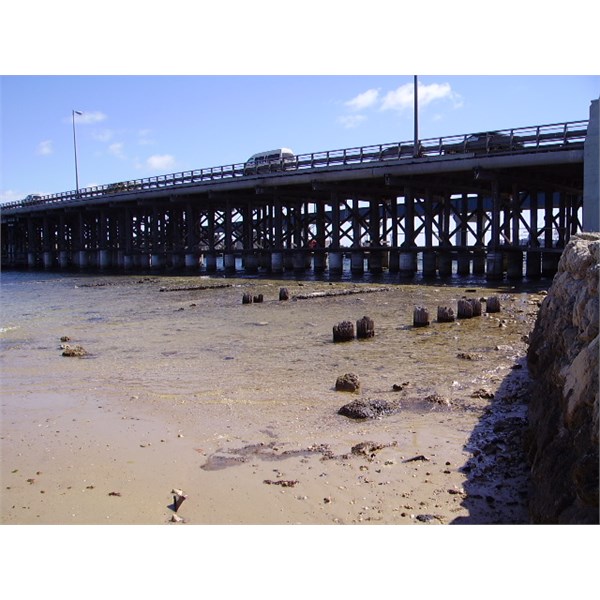
You can still see the remains of the 1866 stick bridge
.